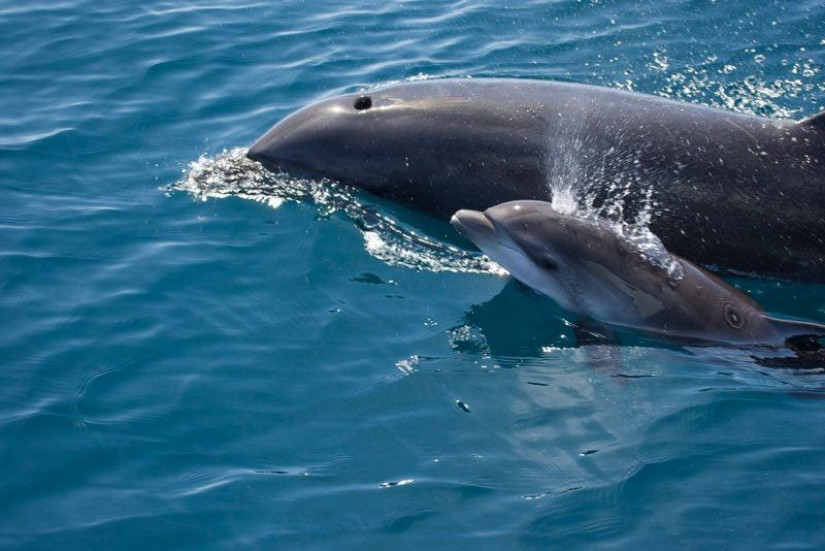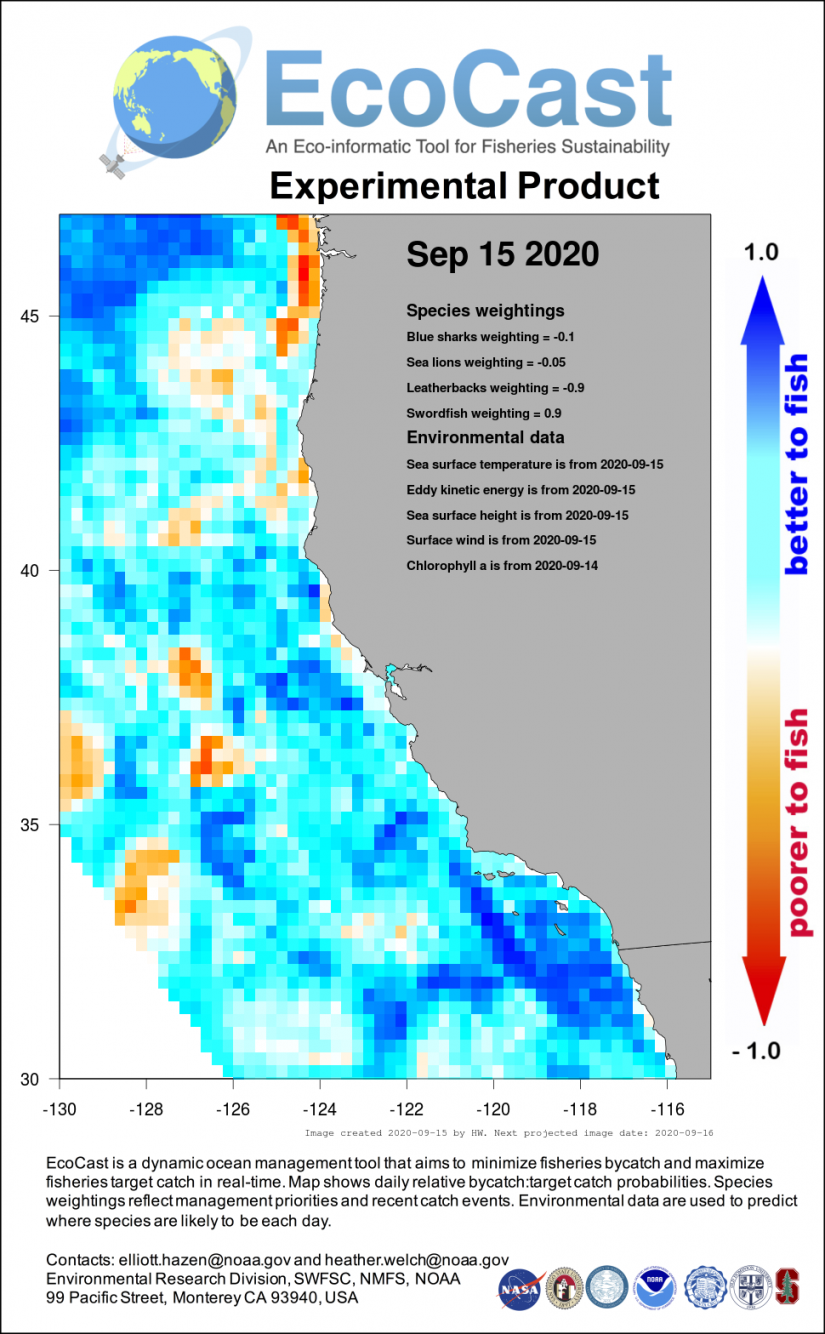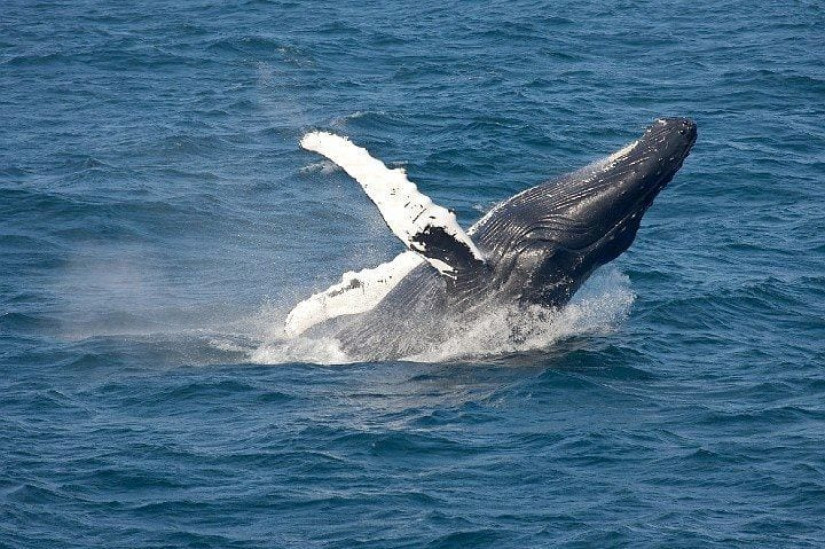Bycatch—the unintended capture of non-targeted species—has long been a major hurdle for California’s drift gillnet swordfish fishery. This is particularly problematic among cetaceans (whales and dolphins) which are all protected under the U.S. Marine Mammal Protection Act, and certain species of which may also be threatened or endangered. The risk of cetacean bycatch can result in closures and regulations to the fishery, which helps protect these at-risk species, but can also put a financial strain on the livelihoods of those working the fishing boats.
One California Sea Grant-funded research project aimed to help address bycatch in the drift gillnet fishery by incorporating data on cetaceans into the EcoCast bycatch modeling framework. Results from this project were recently published in Ecology and Evolution, evaluating the performance of two different models for predicting when and where dolphins and whales may be present.

How does the EcoCast system work? Think of it like a weather forecast, only instead of storm fronts, it uses oceanographic data to predict where targeted species and certain protected species are more likely to be, so that fishers can choose the best areas to fish while avoiding areas likely to have higher levels of bycatch. “We use forecasts and real-time information every day in our life, when we're checking weather, when we're looking at traffic, when we're trying to book flights,” says Elliott Hazen, lead NOAA researcher developing EcoCast. “And this is just another area where we can add additional information to the human decision making process.”
The EcoCast framework already includes a number of important bycatch species, including leatherback sea turtles, sea lions, and blue sharks. By incorporating more species—such as dolphins and whales—into the framework, researchers hope to make it increasingly beneficial to both fishers and fisheries managers.
“And so now, all of these different species are actually feeding into this real-time management tool,” says Elizabeth Becker, NOAA researcher and lead author on the new study. “So the tool allows you to pick out the species you're interested in—or look at all of them—to try to serve as a pre-mitigation measure. So sword fishermen ideally would avoid those areas where they are more likely to have bycatch.”

In order to accomplish this feat, researchers must generate predictive models using a variety of oceanographic and biological data. As these predictions can be done using a variety of different modeling frameworks, the team thought it important to evaluate the performance of two such methods: generalized additive models and boosted regression trees. Each method could prove useful for different species and circumstances, so the results from this paper can help better inform when each type of model is used.
While the predictive ability is not perfect—forecasting rarely is—this EcoCast framework provides one more advantage for those looking to reduce bycatch. “We've had lots of good cross validation studies that look at the predictive ability of these models, but it's not perfect,” says Becker. “We might forecast an area that has a high abundance of a certain species, and that's not guaranteed. But it’s another decision support tool to add to the toolbox.”
Going forward, the researchers hope to continue improving on the accuracy and resolution of these models. Currently, these cetacean models can achieve 10 x 10 kilometers in horizontal resolution, which can still be a large area to address for certain issues. Achieving a finer scale resolution “would certainly be a long term goal, because I think that would be more effective for a lot of the management issues that we're challenged with,” says Becker.
So far, drift gillnet fishers are using EcoCast on a voluntary basis. But in the long-term, researchers foresee this technology being expanded into other fisheries beyond large-mesh gillnets. The ability to predict regions of potential bycatch can likely prove useful for every fishery on the West Coast. And its early adoption within one of the fisheries with a long history of addressing bycatch through cooperation among fishermen, scientists, and managers can help pave the way for this technology to become more widespread.

“The [swordfish] fishery has also been early adopters of things like pingers, changing mesh size, changing set times, and changing the depth, to be as sustainable as possible,” says Hazen. “So my argument is, if you have a fishery that's really interested in working with you, and is adhering well to the management concerns, you should keep trying to keep it as sustainable and operational as possible.”
As the impacts of climate change continue altering species dynamics and ecosystems, adaptive fisheries management will be necessary to meet the changing needs of the future. To continue improving the sustainability of U.S. fisheries, tools like EcoCast can prove increasingly helpful.
“One of the things I really like about this dynamic ocean management is that it is a form of climate-ready management, right?” says Hazen. “Our models are responding to changes in the environment. So as long as species-environment relationships hold, we can be in front of climate change effects on marine ecosystems. And that's something I think we need to look more and more toward such tools in the current environment.”
About California Sea Grant
NOAA’s California Sea Grant College Program funds marine research, education and outreach throughout California. Headquartered at Scripps Institution of Oceanography at the University of California San Diego, California Sea Grant is one of 34 Sea Grant programs in the National Oceanic and Atmospheric Administration (NOAA), U.S. Department of Commerce.